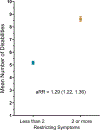Association Between Restricting Symptoms and Disability After Critical Illness Among Older Adults
- PMID: 39298623
- PMCID: PMC12019769
- DOI: 10.1097/CCM.0000000000006427
Association Between Restricting Symptoms and Disability After Critical Illness Among Older Adults
Abstract
Objectives: Older adults who survive critical illness are at risk for increased disability, limiting their independence and quality of life. We sought to evaluate whether the occurrence of symptoms that restrict activity, that is, restricting symptoms, is associated with increased disability following an ICU hospitalization.
Design: Prospective longitudinal study of community-living adults 70 years old or older who were interviewed monthly between 1998 and 2018.
Setting: South Central Connecticut, United States.
Patients: Two hundred fifty-one ICU admissions from 202 participants who were discharged alive from the hospital.
Interventions: None.
Measurements and main results: Occurrence of 15 restricting symptoms (operationalized as number of symptoms and presence of ≥ 2 symptoms) and disability in activities of daily living, instrumental activities of daily living, and mobility was ascertained during monthly interviews throughout the study period. We constructed multivariable Poisson regression models to evaluate the association between post-ICU restricting symptoms and subsequent disability over the 6 months following ICU hospitalization, adjusting for known risk factors for post-ICU disability including pre-ICU disability, frailty, cognitive impairment, mechanical ventilation, and ICU length of stay. The mean age of participants was 83.5 years ( sd , 5.6 yr); 57% were female. Over the 6 months following ICU hospitalization, each unit increase in the number of restricting symptoms was associated with a 5% increase in the number of disabilities (adjusted rate ratio, 1.05; 95% CI, 1.04-1.06). The presence of greater than or equal to 2 restricting symptoms was associated with a 29% greater number of disabilities over the 6 months following ICU hospitalization as compared with less than 2 symptoms (adjusted rate ratio, 1.29; 95% CI, 1.22-1.36).
Conclusions: In this longitudinal cohort of community-living older adults, symptoms restricting activity were independently associated with increased disability after ICU hospitalization. These findings suggest that management of restricting symptoms may enhance functional recovery among older ICU survivors.
Copyright © 2024 by the Society of Critical Care Medicine and Wolters Kluwer Health, Inc. All Rights Reserved.
Conflict of interest statement
Drs. Jain, Ferrante, and Gill received support from the Claude D. Pepper Older Americans Independence Center at Yale School of Medicine (P30AG021342). Dr. Jain was supported by the Parker B. Francis Family Foundation Fellowship Award, the Yale Physician-Scientist Development Award, the National Institute on Aging (NIA), and the National Institutes of Health (NIH) under Award Number R03AG078942. During the course of this work, Dr. Ferrante was supported by a Paul B. Beeson Emerging Leaders in Aging Career Development Award (K76 AG057023). Dr. Feder was supported by National Heart, Lung, and Blood Institute K12HL138037. Drs. Han, Leo-Summers, Ferrante, and Gill received support for article research from the NIH. Drs. Leo-Summers’s and Gill’s institution received funding from the NIH. Dr. Ferrante’s institution received funding from the NIA. Dr. Gahbauer has disclosed that she does not have any potential conflicts of interest.
Figures


Similar articles
-
Critical Illness, Major Surgery, and Other Hospitalizations and Active and Disabled Life Expectancy.JAMA Netw Open. 2025 Apr 1;8(4):e254208. doi: 10.1001/jamanetworkopen.2025.4208. JAMA Netw Open. 2025. PMID: 40178853 Free PMC article.
-
Exercise rehabilitation following intensive care unit discharge for recovery from critical illness.Cochrane Database Syst Rev. 2015 Jun 22;2015(6):CD008632. doi: 10.1002/14651858.CD008632.pub2. Cochrane Database Syst Rev. 2015. PMID: 26098746 Free PMC article.
-
Early intervention (mobilization or active exercise) for critically ill adults in the intensive care unit.Cochrane Database Syst Rev. 2018 Mar 27;3(3):CD010754. doi: 10.1002/14651858.CD010754.pub2. Cochrane Database Syst Rev. 2018. PMID: 29582429 Free PMC article.
-
Community-based complex interventions to sustain independence in older people, stratified by frailty: a systematic review and network meta-analysis.Health Technol Assess. 2024 Aug;28(48):1-194. doi: 10.3310/HNRP2514. Health Technol Assess. 2024. PMID: 39252602 Free PMC article.
-
Exercise for acutely hospitalised older medical patients.Cochrane Database Syst Rev. 2022 Nov 10;11(11):CD005955. doi: 10.1002/14651858.CD005955.pub3. Cochrane Database Syst Rev. 2022. PMID: 36355032 Free PMC article.
References
-
- Needham DM, Bronskill SE, Calinawan JR, et al.: Projected incidence of mechanical ventilation in Ontario to 2026: Preparing for the aging baby boomers. Crit Care Med 2005; 33(3):574–579 - PubMed
-
- United States Census Bureau. The U.S. Joins Other Countries With Large Aging Populations. Published March 13, 2018. Updated October 8,2019. Accessed January 9, 2021. Available at: https://www.census.gov/library/stories/2018/03/graying-america.html). Accessed
-
- Wunsch H, Guerra C, Barnato AE, et al.: Three-Year Outcomes for Medicare Beneficiaries Who Survive Intensive Care. JAMA-J Am Med Assoc 2010; 303(9):849–856 - PubMed
MeSH terms
Grants and funding
LinkOut - more resources
Full Text Sources

